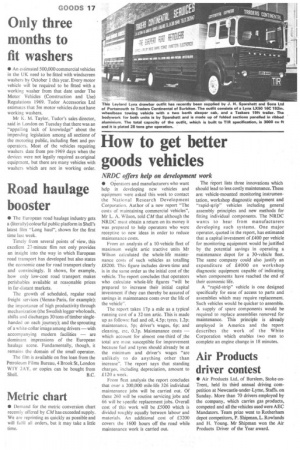How to get better goods vehicles
Page 19

If you've noticed an error in this article please click here to report it so we can fix it.
NRDC offers help on development work
• Operators and manufacturers who want help in developing new vehicles and equipment were asked this week to contact the National Research Development Corporation. Author of a new report "The costs of maintaining commercial vehicles", Mr L. A. Wilson, told CM that although the NRDC must obtain a return on its money it was prepared to help operators who were receptive to new ideas in order to reduce maintenance costs.
From an analysis of a 10-vehicle fleet of maximum weight attic tractive units Mr Wilson calculated the whole-life maintenance costs of such vehicles as totalling £8200. This figure includes down-time and is in the same order as the initial cost of the vehicle. The report concludes that operators who calculate whole-life figures "will be prepared to increase their initial capital investment if they can thereby be assured of savings in maintenance costs over the life of the vehicle".
The report takes 17p a mile as a typical running cost of a 32-ton artic. This is made up as follows: fuel and oil, 4.5p; tyres, 1.2p; maintenance, 5p; driver's wages, 6p; and cleaning, etc, 0.3p. Maintenance costs — which account for almost one-third of the total are most susceptible for improvement because fuel and tyres should already be at the minimum and driver's wages "are unlikely to do anything other than increase". The report says that standing charges, including depreciation, amount to £120 a week.
From fleet analysis the report concludes that over a 200,000 mile-life 326 individual maintenance jobs will be carried out. Of these 260 will be routine servicing jobs and 66 will he specific replacement jobs. Overall cost of this work will be £5000 which is divided roughly equally between labour and materials. An additional cost of £3200 covers the 1600 hours off the road while maintenance work is carried out. The report lists three innovations which should lead to less costly maintenance. These are: vehicle-mounted monitoring instrumentation, workshop diagnostic equipment and "rapid-grip" vehicles including general assembly principles and new methods for fitting individual components. The NRDC wants to hear from manufacturers developing such systems. One major operator, quoted in the report, has estimated that a capital investment of £400 per vehicle for monitoring equipment would be justified by the potential savings in operating a maintenance depot for a 30-vehicle fleet. The same company could also justify an expenditure of £4000 on workshop diagnostic equipment capable of indicating when components have reached the end of their economic life.
A "rapid-strip" vehicle is one designed specifically for ease of access to parts and assemblies which may require replacement. Such vehicles would be quicker to assemble. A supply of spare components would be required to replace assemblies removed for maintenance. This principle is already employed in America and the report describes the work of the White Corporation which enables two men to complete an engine change in 18 minutes.




























































































